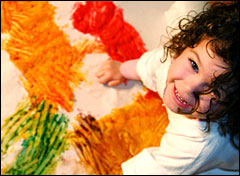Hey Umbra,
I’ve got a niece with a second birthday coming up and I’d like to get her a present that doesn’t involve sitting in front of a computer or TV. So, I thought, how about an art set? What better way to get those creative juices going at an early age than some finger paint and crayons? But crayons must have some crazy toxins in them, and what about finger paint … do I need to be concerned? I’ve heard about veggie paints, but don’t know where one can find them — or how to make them. Ideas please!
Sudha N.
Seattle, Wash.
Dearest Sudha,
Children’s art supplies are a fabulous gift idea, and if you follow a few simple guidelines, there’s little need for concern. The bigger problem with child art is that the freeform techniques of the toddler atelier may freak out neatnik parents and cause many opportunities for battles of the will. If your relations are fastidious, may I suggest including a smock in the kit? Perhaps a miniature dropcloth and several large sponges? Maybe a large fence, to create a hermetic seal around the art area? Plus a parenting book helpful in the toddler years — such as Becoming the Parent You Want To Be?

It’s beautiful! What is it? Tell me about it.
The toddler art set should include modeling clay, crayons, paints, and colorful papers, with glue, tape, and scissors for the overseeing adult. Kids also love stickers.
The reason kids’ supplies are differentiated from adult supplies is that “adult” art stuff often relies on harmful ingredients. Paint dyes can contain heavy metals; there are solvents in paint, glue, and markers; modeling clays contain vinyl; powders and sprays pose inhalation hazards, etc. Obviously all these problems aren’t so great for grown-ups either, but we are larger, don’t randomly eat our toys, and have the option of turning on ventilation, wearing protective gear, and making our own choices about danger.
Shop at a store that sells children’s art products. The products should be certified as non-toxic. At a minimum they should bear two seals: the federally mandated “conforms with ASTM D-4236” (meaning they have been properly labeled as to their chronic health hazards) and a seal from the Art and Creative Materials Institute. The ACMI seals will say either AP for approved product, or the older but similar CP for certified product. Do not buy any art supplies with a Warning, Caution, or Danger label — or a Poison label, of course.
Crayons aren’t too complicated — Crayolas are made out of paraffin wax and pigment, and the label is stuck on with cornstarch and water. There have been a couple scares about lead and asbestos in crayons. I truly believe that the major child craft manufacturers are doing their best with quality control — any bad toxics incident would put them out of business — but sometimes things appear where you least expect them. The asbestos was related to a talc used in the crayons; it’s debated as to how bad it was, and of course it has been eliminated.
That said, if you can find craft supplies that have few ingredients, and list all of them, they are likely less potentially hazardous than those peddled by the mainstream manufacturers. Beeswax crayons are one example. The trouble is, these “natural” supplies can be quite expensive. I would find them at my local hippie/hipster toy shop, or by searching “natural art supplies for kids” online.
For more details in each category of art supply, our friends at the Washington Toxics Coalition have a handy chart of what to avoid and to choose. They have links to a dough recipe, and finger paint recipes abound on the www, with easy-to-find ingredients and ideas for vegetable-based dyes such as onion skins and beets.
Your idea is a great one, and there’s no need for concern, just basic common sense. Don’t forget to spend time making art with your niece. Toddlers need companions to encourage, teach, and assist them. And people of all ages need some low-pressure art time.
Artistically,
Umbra


